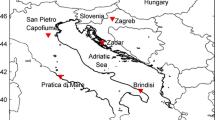Abstract
The technology of waterspout monitoring over the Russian part of the Black Sea is presented. The technology was developed using the foreign experience of tornado and waterspout prediction and the data from the meteorological observation network of the Russian Federation. The technology is based on the software for the organization and maintenance of operational database including the data of satellite imagery, numerical weather prediction models, lightning detection systems, and weather radars. It was found that the results of the use of the presented technology for analyzing waterspout-risk conditions during the waterspout season are of the greatest interest. The waterspout season in the Black Sea area usually begins in May and ends in September. The review of waterspout occurrence over the Russian part of the Black Sea in 2014 is presented.
Similar content being viewed by others
References
M. V. Kurganskii, A. V. Chernokul’skii, and I. I. Mokhov, “The Tornado over Khanty-Mansiysk: An Exception or a Symptom?”, Meteorol. Gidrol., No. 8 (2013) [Russ. Meteorol. Hydrol., No. 8, 38 (2013)].
G. I. Mazurov, B. A. Vasil’ev, and V. I. Akselevich, “Analysis of Tornado Parameters in Russia for the Period of a Century and a Half. Research Activities of Roshydromet Aviamettelekom,” Meteospektr, No. 4 (2011) [in Russian].
A. I. Snitkovskii, “Tornados in the USSR,” Meteorol. Gidrol., No. 9 (1987) [Sov. Meteorol. Hydrol., No. 9 (1987)].
Algorithm Theoretical Basis Document for “Rapid Development Thunderstorms,” http://www.nwcsaf.org/scidocs/Documentation/SAF-NWC-CDOP2-MFT-SCI-ATBD-11_v3.0d.pdf.
C. A. Doswell, S. J. Weiss, and R. H. Johns, “Tornado Forecasting—A Review,” Geophys. Monograph. Series, 79 (1993).
European Severe Weather Database, http://webbox.eswd.eu/cgi-bin/eswd.cgi.
Explanation of SPC Severe Weather Parameters, http://www.spc.noaa.gov/sfctest/help/sfcoa.html.
C. Marzban and G. J. Stumpf, “A Neural Network for Tornado Prediction Based on Doppler Radar-derived Attributes,” J. Appl. Meteorol., 35 (1996).
NCEP Products Inventory, http://www.nco.ncep.noaa.gov/pmb/products/gfs/.
L. Nisi, P. Ambrosetti, and L. Clementi, “Nowcasting Severe Convection in the Alpine Region: The COALITION Approach,” Quart. J. Roy. Meteorol. Soc., 140 (2014).
Presentation of Severe Weather Parameters, http://www.crh.noaa.gov/lmk/soo/presentations/svr_parameters.pdf.
J. Rauhala and D. M. Schultz, “Severe Thunderstorm and Tornado Warnings in Europe,” Atmos. Res., 93 (2009).
The Eumetsat Network of Satellite Application Facilities—Support to Nowcasting and Very Short Range Forecasting, http://nwcsaf.org.
Author information
Authors and Affiliations
Corresponding author
Additional information
Original Russian Text © O. V. Kalmykova, V.M. Shershakov, 2016, published in Meteorologiya i Gidrologiya, 2016, No. 10, pp. 93-102
About this article
Cite this article
Kalmykova, O.V., Shershakov, V.M. A technology of waterspout monitoring over the Russian part of the Black Sea. Russ. Meteorol. Hydrol. 41, 728–734 (2016). https://doi.org/10.3103/S1068373916100095
Received:
Published:
Issue Date:
DOI: https://doi.org/10.3103/S1068373916100095




